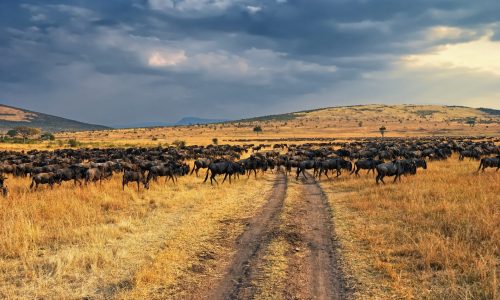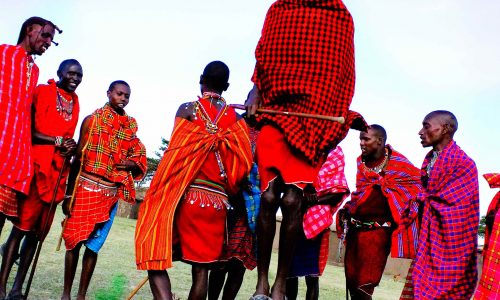Kenya
Journey through the country exploring wildlife & culture
Why travel to Kenya? The Great Rift Valley flows through the heart of the country. Enticing you to explore some of the most spectacular wildlife experiences on the planet.
Over 42 known tribes, the Bantu community makes up a majority of the country’s local residents.
An African safari in Kenya is an unforgettable experience that offers the opportunity to witness some of the world’s most magnificent wildlife in their natural habitat. In addition to the incredible wildlife, East Africa is also home to Mount Kenya. The second highest mountain on the continent. The Ngong Hills, located at the foot of the mountain, were gifted to the Kenyan government by the Danish in 1964 as a symbol of independence.
Today, the area is home to one of Kenya’s national museums, which opened its doors to the public in 1986.
Kiswahili and English are the official languages, the latter more widely spoken within schooling and government areas. Samburu tribesman in the north, are related to the nomadic Masai. Distinctively different in their cultural dress and semi nomadic ways.
Kenya | When to Travel
Kenya’s diverse geography makes for a wide range of temperatures. The climate is tropical, hot and humid in low lying coastal areas, with a refreshing coolness in the rift valley highlands.
The equator running through the central plateau of Laikipia, allows temperatures to be consistent year round. The northern arid desert of Lake Turkana is mainly dry with the occasional rain. Kenya is a popular destination to visit any time of the year, though the best times are generally outside of the rainy seasons, when wildlife is abundant. Long rains start towards the end of March through to May, with the shorter rains in the month of November.
From December to March…
The rains are over by December, giving way to clear skies as the warmer weather approaches. With January and February being the hottest months of the year. Wildlife congregate around waterholes, and the calmer, warmer weather making it more ideal for diving adventures on the coast. April to May the start of green season temperatures drop as nights become cooler and the long rains begin. Dust clears and brings with it clean air, free from the daily smoke haze. Wildlife viewing is harder, as animals shelter under the lush vegetation that provides a great place to hide.
June to September the rains have eased bringing cooler clear days, the morning mist rolls in over the rift valley and central highlands. The annual migration from the Serengeti starts its journey across the Mara River into Kenya. The herds will form long lines as they head further into the Mara reserve. October to November majority of the wildebeest migration has now moved back over to northern parts of the Serengeti in Tanzania. The short rains in November are about to start, weather is more humid with the dry season fastly approaching.
Region Focus
Arid desert, colourful culture, fertile highlands, snow capped mountains and an endless savannah plains of wildlife. Are just one of the many fascinating attractions in Kenya. A country rich in fascinating wildlife, culture and colourful smiles that will definitely brighten up your day. Featuring scenic views from the top of the Great Valley Rift escarpment spread as far along to Lake Nakuru. Located here are pink flamingos that cover this soda lake in colour.
Great lakes, desert oasis’s and northern frontiers.
The Masai Mara plays an important part of the annual migration of wildebeest and zebra every year. It has a high concentration of resident game such as giraffe, hippo, elephant, lions, leopards and rhino.
The northern frontier of Turkana is a dry arid desert, and home to the Turkana people. Nomadic pastoralists that keep goats, camels, donkeys and cattle. The Elmoro tribe live on the southern shores of Lake Turkana and Mount Kenya the second highest mountain in Africa stands tall. The mountain is home to antelope, colobus monkeys and cape buffalo. On the coast is Lamu Island and the Old Town of Lamu, the oldest preserved town, inhabited for over 700 years.
One of Kenya’s most prominent features is the Great Rift Valley.
The contrast of lush highlands to the soda lakes of the valley floor, is just spectacular. In this region are a few extraordinary wildlife conservancies and national parks. In honour of the Masai people, the Masai Mara National Reserve is best described as the area looked on from afar. “Mara” in Masai language means “Maa” for “spotted” large reflections from various circle shaped clouds or scrub that shadow over the savanna.
In the northern frontier of Kenya, arid desert areas leave behind any part of the country that is luscious and green. Lodwar, a big but small town is the last port of call before heading out to the largest saline lake in East Africa. Whilst you may think that some areas are devoid of life. The lake is a breeding ground for the Nile crocodile, hippos and a stopover for the migratory water fowl.
Ancient lava fields and historic towns.
The Swahili coast of Kenya, full of beautiful and remote beaches, some more popular than others. The old historic town of Lamu, that will insist you take a step back in time. Not forgetting two of Kenya’s less travelled national parks Tsavo East and Tsavo West. One of Kenya’s oldest and interesting national parks is Tsavo East. Tucked away in the south eastern area of the country, it was renamed in 1948. Taken over by the Kenyan government in 1963, the park hasn’t been without its challenges. Elephant ivory poaching over the years has destroyed a large number of these majestic creatures.
For more information on our Kenyan Safaris feel free to give us a call or alternatively pop us an email!
Select another destination below
Want to chat about your next African safari holiday?
Our trip planners are destination specialists and here to help you every step of the way.







